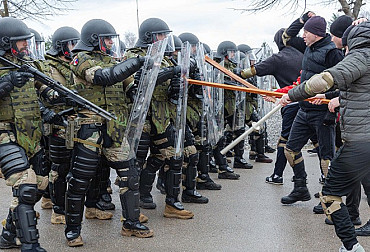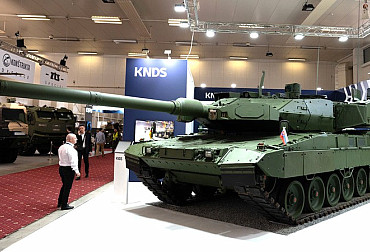Maintenance and care of the BVPs is becoming more complex and time consuming
Twice a year, military vehicle parks come to life with an extraordinary bustle. Unit technicians and drivers of wheeled and tracked vehicles and their crews prepare military equipment and materials for seasonal operation.
 Picture: Unit technicians and drivers of wheeled and tracked vehicles with their crews prepare military equipment and materials for seasonal operation. | Ministry of Defense of the Czech Republic
Picture: Unit technicians and drivers of wheeled and tracked vehicles with their crews prepare military equipment and materials for seasonal operation. | Ministry of Defense of the Czech Republic
"I don't have to explain to any of you that the old BVPs (IFVs) belong to scrap," Army General Aleš Opata emphasized at a recent command meeting of the Czech Arny General Staff. However, even this equipment, until it is replaced by a new one, must still serve and perform given tasks. This is even more true withing the 71st Mechanized Battalion in Hranice, which is still included in the NATO Rapid Reaction Force this year. It must be prepared for possible deployment with fully combat-ready vehicles. However, it costs a lot of effort.
This year's preparation for summer operation is over for the battalion. A total of six weeks was set aside for so-called "transitions". After the administration and entrance inspections, the soldiers went to work to treat the equipment and materials and prepare them for the specific conditions of operation in the summer. "BVPs are older than the soldiers who train with them and service them," mentions the technician of the 1st mechanized company, Sergeant Roman Šima.
 Picture: The entire crew of the vehicle is involved in the work | Ministry of Defense of the Czech Republic
Picture: The entire crew of the vehicle is involved in the work | Ministry of Defense of the Czech Republic
"Their maintenance and care is becoming more complex and time consuming. We need to inspect all groups of vehicles in detail, both the chassis and the weapon systems, and eliminate any defects found. Of course, the addition of operating fluids and proper lubrication of lubrication points. Fortunately, drivers are "enthusiasts" and help each other to solve problems. It often happens that up to ten technicians think over a defect. Thanks to this enthusiasm, all vehicles are operational," Sergeant Šima adds.
Infantry Fighting Vehicle (BVP) 2 is another modification of the BVP series, structurally based on the BVP-1 fighting vehicle. It is also a light combat amphibious tracked vehicle with high mobility and armor protection. Passability through the terrain is improved by using a different type of tracks and modifying the chassis shock absorbers. The vehicle is designed to increase the mobility and firepower of infantry, to protect it on the battlefield, to destroy various armored targets, including tanks and combat helicopters and enemy manpower. BVP-2 has been serving in our Army since the late 1980s and their replacement with a more modern IFV is necessary.
 Picture: Maintenance and care of the BVPs is becoming more and more complicated and time consuming | Ministry of Defense of the Czech Republic
Picture: Maintenance and care of the BVPs is becoming more and more complicated and time consuming | Ministry of Defense of the Czech Republic
In connection with the above, we asked the press information officer of the 71st Mechanized Battalion, Capt. Radek Hampl, the following questions:
What needs to be serviced or repaired on the BVP as part of transitions and routine maintenance?
All equipment and weapons of the vehicle are serviced. The vehicle's paintwork is repaired, damaged or worn parts are repaired or replaced. It is a set of operations described in the regulation Tank-26-7. From cleaning the crew helmets to repairing the paint on the underside of the chassis.
Basic maintenance is performed once every 14 days. This maintenance is performed by the driver and includes inspection of all vehicle systems, their tightness, functionality and completeness. Furthermore, the lubrication of the vehicle is checked according to the lubrication schedule.
Preparation of equipment for seasonal operation (PTSP) consists of preparation of the hull, adjustment of the air supply to the engine, preparation of the fuel, cooling and air system, preparation of the chassis, preparation of the cleaning equipment of observation devices. Then there is the preparation of fire protection equipment, preparation of vehicle equipment, inspection of the electric starter, treatment of batteries, treatment of paint and elimination of faults in the entrance control. PTSD on weapons is performed separately.
How long does it take on average to work on one BVP within transitions and routine maintenance?
It depends on the number of soldiers who help. The complete crew should participate, but due to the busy schedule of troops in courses and other activities, the preparation is mostly carried out only by the driver and the gunner. It is very individual for each BVP due to the age of the vehicles and their use. It can take 1 week but also 2 months. Routine maintenance after use, etc. can be done in 1 to 2 days.
According to the regulation, the time for performing PTSD is 300 minutes, but in reality this activity requires double the time. This maintenance is performed by 1 person. Routine maintenance - basic maintenance - is then performed once every 14 days and the time for its execution is 240 minutes according to the regulations. This maintenance is performed by 2 people.
This routine maintenance is sufficient or extraordinary repairs are in progress. At what frequency? What is the most faulty part?
Routine maintenance only extends the life of all parts and thus the entire BVP. It depends on the quality with which it is performed. Every machine breaks down one day.
Extraordinary repairs are ongoing. The technology is used for training and with it comes the wear of components such as bearings, tracks, roadwheels, but also due to the age of the vehicles, there are also major repairs, such as engine replacement.
BVP engines are prescribed to be overhauled or repaired after 7,000 km or 10 years, and some vehicles have already driven 10,000 km and are still running. I don't even have to mention the age of the vehicles. How many people have a veteran at home?
Routine maintenance is definitely not enough, the main reason is the age of the vehicles. Extraordinary repairs take place within the unit, by military and non-military repairers, and their frequency is variable, but it has become more frequent recently. The most faulty are engines that are built for a certain number of km untill the overhaul is needed. These overhauls have not been carried out in recent years.
What is the situation in the supply of spare parts? Are there enough even if the purchase of new IFVs is delayed?
The situation with spare parts is still quite sustainable. At least as far as the main ones are concerned, such as the already mentioned wheels, etc. We are the last brigade using the BVPs and there are still plenty of basic supplies in stock from the previous period, but they are also shrinking.
There is more problems with special vehicles, such as the BVP-VPV (recovery tracked vehicle), or some modernized vehicles and their modifications with special superstructures, which are few in the Army. The special equipment that these vehicles have is not in the Army's stockpile and can no longer be found in civilian sources either, which is why their repair is very expensive and time-consuming.
Some parts must be manufactured by specialist companies. I do not know what the real conditions are in Army warehouses. However, most spare parts are not available. All repairs are carried out in limited quantities due to non-delivery of spare parts.





















